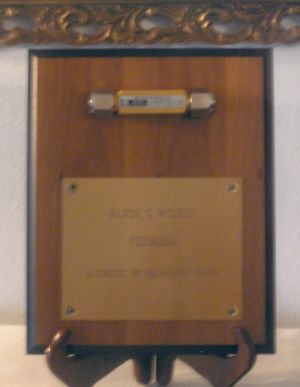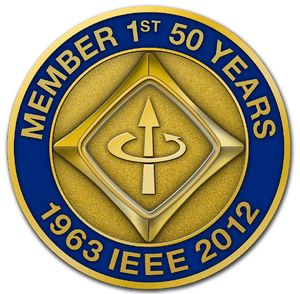First-Hand:My Recollections in Electrical Engineering
My Recollections in Electrical Engineering

Submitted by Alvin C. Wilson
I served in General Patton's Third U.S. Army in Europe in WWII as a Radio Operator and Technician for the Headquarters Battery Commander in the 273rd Field Artillery Battalion (155 mm Long Tom cannon). I landed on Utah Beach in Normandy and was in the Battle of the Bulge. I received all five 3rd Army Battle Campaign Stars. This was the start of my interest in electricity and communications.
I graduated from the University of Colorado in 1948 with a B.S. in Electrical Engineering. After working for an oil company in Texas and an Electrical Products Manufacturer in Denver, I started my career in 1950 by teaching radar bombing systems to Air Force Technicians at Lowery A.F.B. in Denver. The first time that I had any contact with a computer was the mechanical computer that controlled the flight of bombers to reach and bomb the desired target. The computer was a metal frame being about a two-foot cube in size, housing a large number of cams, stops and many gears. I remember the first large computer that NBS had used so many vacuum tubes that it had to have special air conditioning to be kept cool. Computers have come a long ways over the last 60 years.
I transferred to the National Bureau of Standards when it moved from Washington, D.C. to Boulder in 1954. I actually had two careers at N.B.S. Labs. My first career was in antenna design and testing. I authored or co-authored nineteen published papers on the antenna design and test. I can remember the many large rhombic and corner reflector antennas that we worked with. The TV antennas that we tested were small in comparison. Communication antennas are now reduced to a printed circuit or a short wire.
My second N.B.S. career started when I transferred to the Electromagnetic Division. This division had the responsibility to test and calibrate electronic parts for power, impedance, and other microwave items such as waveguides and horn antennas. While I was in charge of the calibration reports, the Division Chief, Dr. Raymond Sangster, sent me out coast to coast and every place in between to visit the calibration laboratories that we serviced, both military and civilian. After defining the needs of our customers, I knew that there had to be a faster and better way to satisfy the needs of other laboratories.
I realized that it was time for starting the use of computers to perform the measurements much faster and more accurately. I started making plans to start a users group to speed up the calibrations by the use of computers. Shortly after this decision, I attended an IEEE Meeting in 1972 in Los Angeles where I met and discussed the idea of a computer users group. I met three men at the meeting who liked the idea. They were Edward Stevens (RCA), John Meeker(Westinghouse), and Allan Holly (Hughes). The four of us met and named the users group ((ARFTG" for Automatic RF Techniques Group. This group started out informally with no budget or dues. The ARFTG has become a part of the Microwave Theory and Techniques group of the IEEE. ARFTG meetings have been held at least twice a year since 1972.
The Electromagnetics Division Chief decided that the fastest way that the NBS could get a start in computer controlled measurements would be to buy a newly developed Network Analyzer developed and sold by the Hewlett Packard Co.. This served as a base for NBS to get started in Computer aided calibrations. A new way to disseminate calibrations was for ARFTG to have microwave items calibrated at NBS and then place them in traveling kits to be sent to ARFTG members to trace their calibrations to NBS.
In 1976 the Electromagnetics Division decided that they no longer needed my position as a calibration coordinator and offered me a position in another field of work at NBS. I was over 50 years old and had over 27 years credit time so I chose to retire rather than starting another career at NBS. I guess that I might say that my interests in computers to control calibrations was the reason that NBS did not need to continue with my coordinator position. Although I keep busy with my wife's and my business interests, I still enjoy reading and learning about new technologies.
Now that I am almost 87 years old, I believe the greatest technology change was the invention of the transistor and the printed circuit technology. At one time in my career, I knew everything that there was to know about the use of vacuum tubes and their use in circuits.
